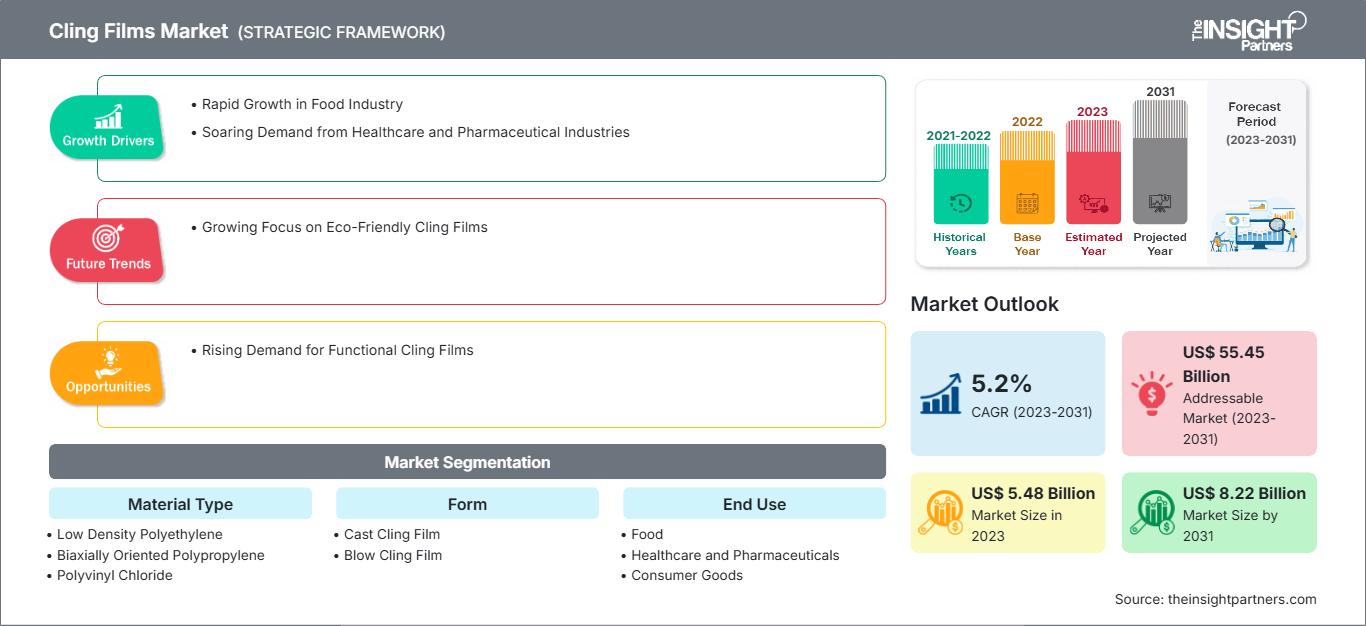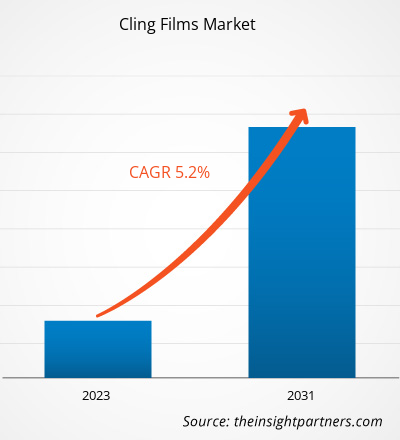Der Markt für Frischhaltefolien soll von 5,48 Milliarden US-Dollar im Jahr 2023 auf 8,22 Milliarden US-Dollar im Jahr 2031 anwachsen. Für den Zeitraum 2023–2031 wird ein durchschnittliches jährliches Wachstum von 5,2 % erwartet. Die steigende Nachfrage nach Fertiggerichten und frischen Lebensmitteln wird voraussichtlich ein wichtiger Markttrend bleiben.
Marktanalyse für Frischhaltefolien
Frischhaltefolien, auch Plastikfolien, Lebensmittelverpackungen oder Stretchfolien genannt, sind dünne, flexible Kunststofffolien, die hauptsächlich zum Abdecken und Versiegeln von Industrieprodukten, Konsumgütern, Arzneimitteln und Lebensmitteln verwendet werden. Diese Folien werden aus Materialien wie Polyethylen (PE), Polyvinylchlorid (PVC) und Polyvinylidenchlorid (PVDC) hergestellt. Ihre Hauptmerkmale sind ihre Fähigkeit, an Oberflächen zu haften, eine dichte Versiegelung zu bilden und transparent zu bleiben. Frischhaltefolien werden in der Industrie, im Haushalt, in Supermärkten und in der Gastronomie häufig verwendet, um Lebensmittel zu verpacken und vor Verunreinigungen, Feuchtigkeit und Luft zu schützen und so die Haltbarkeit der Produkte zu verlängern. Sie werden aufgrund ihrer praktischen Handhabung, Benutzerfreundlichkeit und Wirksamkeit bei der Erhaltung der Lebensmittelqualität geschätzt.
Marktübersicht Frischhaltefolien
Der Markt für Frischhaltefolien wird durch die steigende Nachfrage nach Fertiggerichten, das zunehmende Bewusstsein für Lebensmittelsicherheit und den technologischen Fortschritt bei Folienmaterialien angetrieben. Zu den wichtigsten Materialien bei der Herstellung von Frischhaltefolien gehören Polyethylen (PE) aufgrund seiner Kosteneffizienz und Flexibilität, Polyvinylchlorid (PVC) aufgrund seiner hervorragenden Hafteigenschaften trotz Umweltbedenken und Polyvinylidenchlorid (PVDC) aufgrund seiner hervorragenden Barriereeigenschaften. Innovationen konzentrieren sich auf die Verbesserung dieser Eigenschaften bei gleichzeitiger Verbesserung der Nachhaltigkeit. Der zunehmende Bedarf an effektiven Verpackungslösungen für Verbraucher- und Industrieanwendungen treibt das Marktwachstum voran.
Passen Sie diesen Bericht Ihren Anforderungen an
Sie erhalten kostenlos Anpassungen an jedem Bericht, einschließlich Teilen dieses Berichts oder einer Analyse auf Länderebene, eines Excel-Datenpakets sowie tolle Angebote und Rabatte für Start-ups und Universitäten.
Markt für Frischhaltefolien: Strategische Einblicke

-
Holen Sie sich die wichtigsten Markttrends aus diesem Bericht.Dieses KOSTENLOSE Beispiel umfasst Datenanalysen, die von Markttrends bis hin zu Schätzungen und Prognosen reichen.
Markttreiber und -chancen für Frischhaltefolien
Steigende Nachfrage nach Frischhaltefolien in der Lebensmittelindustrie treibt Marktwachstum an
Die steigende Nachfrage nach frischen, nahrhaften und schmackhaften Lebensmitteln erfordert innovative und kontaminationsfreie Verpackungslösungen, um Lebensmittel vor dem Verschütten zu schützen, die Haltbarkeit zu verlängern und die Qualität zu bewahren. Frischhaltefolien schützen Produkte während des gesamten Distributionsprozesses. Mit ihrer Fähigkeit, Lebensmittel dicht zu verschließen, bieten Frischhaltefolien eine effiziente Lösung für die Verpackung verderblicher Waren wie Gemüse, Obst, Fleisch und Milchprodukte. Darüber hinaus treibt die steigende Nachfrage nach Convenience Food und Fertiggerichten den Bedarf an Frischhaltefolien voran, da sie das Verpacken und Konservieren dieser Produkte praktisch machen. Da sich die Verbraucher zunehmend für Lebensmittelsicherheit und -hygiene interessieren, werden Frischhaltefolien aufgrund ihrer Fähigkeit, Lebensmittel vor Verunreinigungen und äußeren Schadstoffen zu schützen, bevorzugt.
E-Commerce hat die Lebensmittelindustrie revolutioniert; Online-Lebensmitteleinkäufe und Essenslieferdienste gewinnen an Popularität. Laut der Europäischen Kommission hatten im Jahr 2022 91 % der 16- bis 74-Jährigen in der Europäischen Union (EU) Zugang zum Internet; 75 % von ihnen hatten Waren oder Dienstleistungen für den privaten Gebrauch gekauft oder bestellt. Der Anteil der E-Shopper stieg von 55 % im Jahr 2012 auf 75 % im Jahr 2022 – ein Anstieg um 20 Prozentpunkte (PP). Online-Lebensmittelplattformen bieten Verbrauchern einen beispiellosen Komfort. Verbraucher durchstöbern eine große Auswahl an Lebensmitteln, geben Bestellungen auf und lassen sich ihre Mahlzeiten bis an die Haustür liefern. Dadurch entfallen Fahrten, Warteschlangen und zeitaufwändige Essensprozesse. Der organisierte Einzelhandel und E-Commerce sind auf effiziente Lieferketten angewiesen, um die Nachfrage der Verbraucher zu erfüllen. Da sich immer mehr Verbraucher für den Online-Einkauf von Lebensmitteln entscheiden, steigt die Nachfrage nach zuverlässigen und effizienten Verpackungsoptionen, um eine sichere Lieferung der Lebensmittel bis an die Haustür zu gewährleisten. Frischhaltefolien spielen in diesem Prozess eine entscheidende Rolle, da sie eine leichte, flexible und schützende Verpackungsoption bieten, die hilft, die Frische und Qualität verderblicher Waren während des Transports zu bewahren. Somit treibt die wachsende Lebensmittelindustrie das Wachstum des Frischhaltefolienmarktes voran.
Wachsender Fokus auf umweltfreundliche Frischhaltefolien fördert Marktwachstum
Verbraucher und Unternehmen legen bei ihren Kaufentscheidungen zunehmend Wert auf Nachhaltigkeit, da das Umweltbewusstsein steigt. Dieses veränderte Verbraucherverhalten beeinflusst Hersteller positiv, Innovationen zu entwickeln und Frischhaltefolienprodukte anzubieten, die aus recycelten Materialien hergestellt, kompostierbar und biologisch abbaubar sind. Im April 2023 brachte Wrapmaster, ein Geschäftsbereich von Melitta UK Ltd, die kompostierbare Frischhaltefolie auf den Markt, eine Allzweckfolie, die in häuslichen oder industriellen Kompostierungsumgebungen biologisch abbaubar ist. Darüber hinaus setzen Regierungen und Umweltorganisationen auf der ganzen Welt strenge Vorschriften und Anreize um, um Plastikmüll zu reduzieren und die Verwendung nachhaltiger Materialien zu fördern. Dieser regulatorische Vorstoß ermutigt Hersteller, umweltfreundliche Produkte zu entwickeln und stärkt das Verbrauchervertrauen in diese Alternativen. Infolgedessen wird erwartet, dass der Markt in Zukunft einen Anstieg der Nachfrage nach umweltfreundlichen Produkten erleben wird, was den Weg für eine nachhaltige Zukunft bei Verpackungsmaterialien in verschiedenen Branchen ebnet.
Segmentierungsanalyse des Marktberichts für Frischhaltefolien
Schlüsselsegmente, die zur Ableitung der Marktanalyse für Frischhaltefolien beigetragen haben, sind Materialtyp, Form und Endverwendung.
- Basierend auf dem Materialtyp wird der Markt für Frischhaltefolien in Polyethylen niedriger Dichte, biaxial orientiertes Polypropylen, Polyvinylchlorid, Polyvinylidenchlorid und andere unterteilt. Das Segment Polyethylen niedriger Dichte hatte 2023 den größten Marktanteil.
- Nach Form wird der Markt in gegossene Frischhaltefolie und Blasfolie unterteilt. Das Segment gegossene Frischhaltefolie hatte 2023 einen größeren Marktanteil.
In Bezug auf die Endverwendung wird der Markt in Lebensmittel, Gesundheitswesen und Pharmazeutika, Konsumgüter, Industrie und andere segmentiert. Im Jahr 2023 dominierte das Industriesegment den Markt.
Marktanteilsanalyse für Frischhaltefolien nach Geografie
Der geografische Umfang des Marktberichts für Frischhaltefolien ist hauptsächlich in fünf Regionen unterteilt: Nordamerika, Asien-Pazifik, Europa, Naher Osten und Afrika sowie Süd- und Mittelamerika.
Im Jahr 2023 dominierte der Asien-Pazifik-Raum den Marktanteil für Frischhaltefolien. Der wachsende Online-Einzelhandel für Lebensmittel und Nahrungsmittel wirkt sich positiv auf die Nachfrage nach Frischhaltefolien aus. Laut der International Trade Administration kaufen 57 % der asiatischen Verbraucher hauptsächlich online ein. Dazu gehört auch der Online-Einkauf von Lebensmitteln und Nahrungsmittelprodukten, die Frischhaltefolien zur Verpackung benötigen. Somit steigert die wachsende Lebensmittelindustrie im Asien-Pazifik-Raum die Nachfrage nach Frischhaltefolien in der gesamten Region.
Europa hielt im Jahr 2023 den zweitgrößten Anteil am Markt für Frischhaltefolien. Der Markt in Europa verzeichnet ein bemerkenswertes Wachstum aufgrund der zunehmenden Verbreitung von Frischhaltefolien in den Bereichen Lebensmittel, Gesundheitswesen und Pharmaindustrie aufgrund ihrer Manipulationssicherheit und der längeren Haltbarkeit. Laut der Europäischen Kommission ist die Lebensmittelindustrie der größte Produktionszweig in Europa und treibt die Nachfrage nach Lebensmittelverpackungsprodukten wie Frischhaltefolien an. Laut der Europäischen Union verfügt die Region über die zweitgrößte Pharmaindustrie der Welt. Dies führt zu einer erhöhten Produktion von Arzneimitteln in der Region und schafft globale Exportmöglichkeiten. Solche Faktoren treiben die Nachfrage nach Frischhaltefolien für die Verpackung von Lebensmitteln und Pharmaprodukten in Europa an.
Frischhaltefolien
Regionale Einblicke in den Markt für Frischhaltefolien
Die Analysten von The Insight Partners haben die regionalen Trends und Faktoren, die den Frischhaltefolienmarkt im Prognosezeitraum beeinflussen, ausführlich erläutert. In diesem Abschnitt werden auch die Marktsegmente und die geografische Lage in Nordamerika, Europa, dem asiatisch-pazifischen Raum, dem Nahen Osten und Afrika sowie Süd- und Mittelamerika erörtert.
Umfang des Marktberichts über Frischhaltefolien
| Berichtsattribut | Einzelheiten |
|---|---|
| Marktgröße in 2023 | US$ 5.48 Billion |
| Marktgröße nach 2031 | US$ 8.22 Billion |
| Globale CAGR (2023 - 2031) | 5.2% |
| Historische Daten | 2021-2022 |
| Prognosezeitraum | 2023-2031 |
| Abgedeckte Segmente |
By Materialtyp
|
| Abgedeckte Regionen und Länder |
Nordamerika
|
| Marktführer und wichtige Unternehmensprofile |
|
Dichte der Marktteilnehmer für Frischhaltefolien: Verständnis ihrer Auswirkungen auf die Geschäftsdynamik
Der Markt für Frischhaltefolien wächst rasant. Die steigende Nachfrage der Endverbraucher ist auf Faktoren wie veränderte Verbraucherpräferenzen, technologische Fortschritte und ein stärkeres Bewusstsein für die Produktvorteile zurückzuführen. Mit der steigenden Nachfrage erweitern Unternehmen ihr Angebot, entwickeln Innovationen, um den Bedürfnissen der Verbraucher gerecht zu werden, und nutzen neue Trends, was das Marktwachstum weiter ankurbelt.

- Holen Sie sich die Markt für Frischhaltefolien Übersicht der wichtigsten Akteure
Marktneuigkeiten und aktuelle Entwicklungen zu Frischhaltefolien
Der Markt für Frischhaltefolien wird durch die Erhebung qualitativer und quantitativer Daten aus Primär- und Sekundärforschung bewertet, die wichtige Unternehmensveröffentlichungen, Verbandsdaten und Datenbanken umfasst. Einige der Entwicklungen auf dem Markt sind unten aufgeführt:
- Berry Global hat eine neue Version seiner Polyethylen-Frischhaltefolie Omni Xtra für Anwendungen mit frischen Lebensmitteln auf den Markt gebracht. Sie bietet eine leistungsstarke Alternative zu herkömmlichen Frischhaltefolien aus Polyvinylchlorid (PVC). Während Omni Xtra eine etablierte Lösung für die Verpackung von Fleisch und Geflügel, Obst und Gemüse sowie Feinkost- und Backwaren ist, verfügt die neue Folie Omni Xtra+ über verbesserte Elastizität, ein gleichmäßigeres Dehnungsverhalten und eine verbesserte Schlagfestigkeit. Sie bietet den Nutzern außerdem erhebliche Nachhaltigkeitsvorteile, einschließlich der Einhaltung der erwarteten Anforderungen der kommenden EU-Verordnung über Verpackungen und Verpackungsabfälle (PPWR) und der erweiterten Herstellerverantwortung (EPR). (Quelle: Berry Global Inc, Pressemitteilung, November 2023)
- Berry Global Group, Inc. gab die Übernahme von F&S Tool bekannt, einem spezialisierten Anbieter von Hochleistungs- und hocheffizienten Heißkanal-Spritzguss- und Großserien-Formpressanwendungen. F&S Tool betreibt eine 8.360 m² große Anlage in Erie, Pennsylvania, mit 11 erteilten/angemeldeten Patenten und 105 engagierten Mitarbeitern, die sich auf bahnbrechende Technologien konzentrieren, um ein breites Spektrum an Kunststoffherstellern zu bedienen. Diese Übernahme wird Berrys globale Werkzeugkapazität weiter ausbauen und proprietäre Technologien im Bereich Verschlüsse und Flaschen einbringen, die speziell auf High-End-Wachstumsmärkte abzielen. (Quelle: Berry Global Inc, Pressemitteilung, April 2024)
Marktbericht zu Frischhaltefolien: Abdeckung und Ergebnisse
Der „Marktbericht zu Frischhaltefolien: Größe und Prognose (2021–2031)“ Der Bericht bietet eine detaillierte Analyse des Marktes und deckt die folgenden Bereiche ab:
- Marktgröße und Prognose für Frischhaltefolien auf globaler, regionaler und Länderebene für alle abgedeckten wichtigen Marktsegmente
- Markttrends und Marktdynamiken für Frischhaltefolien wie Treiber, Einschränkungen und wichtige Chancen
- Detaillierte Porter's Five Forces- und SWOT-Analyse
- Marktanalyse für Frischhaltefolien mit wichtigen Markttrends, globalen und regionalen Rahmenbedingungen, wichtigen Akteuren, Vorschriften und aktuellen Marktentwicklungen
- Branchenlandschaft und Wettbewerbsanalyse mit Marktkonzentration, Heatmap-Analyse, prominenten Akteuren und aktuellen Entwicklungen für den Frischhaltefolienmarkt
- Detaillierte Unternehmensprofile
- Historische Analyse (2 Jahre), Basisjahr, Prognose (7 Jahre) mit CAGR
- PEST- und SWOT-Analyse
- Marktgröße Wert/Volumen – Global, Regional, Land
- Branchen- und Wettbewerbslandschaft
- Excel-Datensatz
Aktuelle Berichte
Erfahrungsberichte
Grund zum Kauf
- Fundierte Entscheidungsfindung
- Marktdynamik verstehen
- Wettbewerbsanalyse
- Kundeneinblicke
- Marktprognosen
- Risikominimierung
- Strategische Planung
- Investitionsbegründung
- Identifizierung neuer Märkte
- Verbesserung von Marketingstrategien
- Steigerung der Betriebseffizienz
- Anpassung an regulatorische Trends






















 Kostenlose Probe anfordern für - Markt für Frischhaltefolien
Kostenlose Probe anfordern für - Markt für Frischhaltefolien